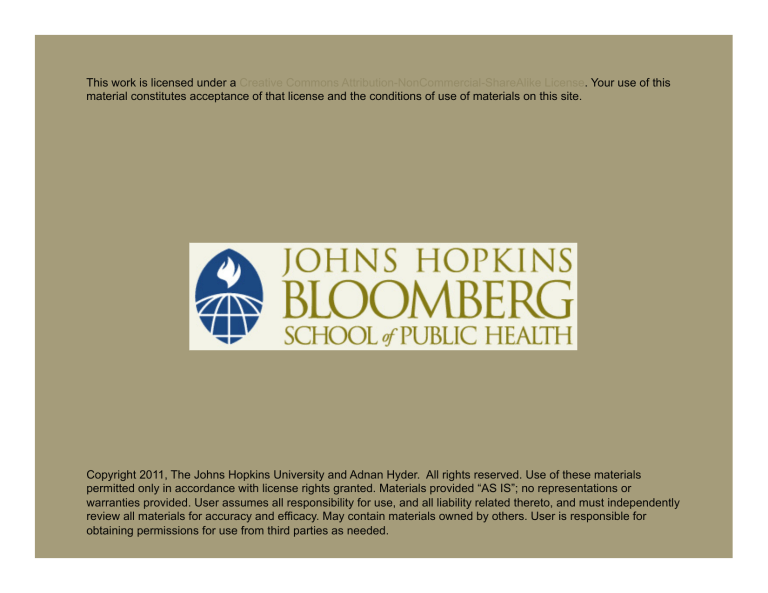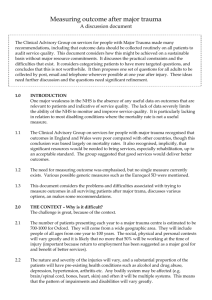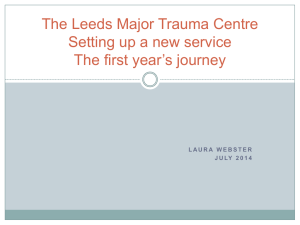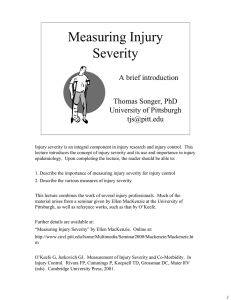This work is licensed under a . Your use of this

This work is licensed under a Creative Commons Attribution-NonCommercial-ShareAlike License . Your use of this material constitutes acceptance of that license and the conditions of use of materials on this site.
Copyright 2011, The Johns Hopkins University and Adnan Hyder. All rights reserved. Use of these materials permitted only in accordance with license rights granted. Materials provided “AS IS”; no representations or warranties provided. User assumes all responsibility for use, and all liability related thereto, and must independently review all materials for accuracy and efficacy. May contain materials owned by others. User is responsible for obtaining permissions for use from third parties as needed.
Section D: Data Sources in Developing
Countries
Adnan Hyder, MD, PhD
Injury Surveys
Ghana
Two-stage cluster sampling and household interviews
21,105 interviewed living in 413 urban and rural sites
1,609 injuries in preceding year
Source: Mock, C. N. et al. (1999). Incidence and outcome of injury in Ghana: A community based survey. Bull WHO, 77, 955–964.
3
Injury Surveys
Burden of disease from nonfatal injuries higher in urban areas
(4,697 disability days/1000 person years) as compared to rural
(2,671 days/1000 person years)
In rural areas, agricultural injuries contributed the highest burden
Source: Mock, C. N. et al. (1999). Incidence and outcome of injury in Ghana: A community based survey. Bull WHO, 77, 955–964.
4
Exploring Hospitalized Injuries
What population is the data based upon?
Which hospitals are included or excluded?
What is the definition of a hospital admission?
What injury-related data are available?
Are denominator data included?
5
Hospital-based Trauma Registries
Uganda
Objectives: establishment of injury surveillance system and assessing severity using Kampala Trauma Score (KTS)
Setting: Mulago hospital, 1,200-bed teaching referral hospital
6
Source: Kobosingve, O. C. et al. (2000) J Trauma, 48, 498–502.
Hospital-based Trauma Registries
Results—first 5,120 records
27.7% females and 71.3% males
7.4% younger than five years
3.9% older than 55 years
75% injuries unintentional
Source: Kobosingve, O. C. et al. (2000) J Trauma, 48, 498–502.
7
Kampala Trauma Score
Contains age and anatomic data
Ordinal scales used for simplicity
Ranges of BP and respiratory rates used in the revised trauma score and the pediatric trauma score collapsed
Glasgow coma scale replaced by 4-point AVPU scale
Highly predictive for admissions or deaths
8
Source: Kobosingve, O. C. et al. (2000) J Trauma, 48, 498–502.
Assessment of Injury Severity
Injury severity (ISS) assessment in South Africa
Studied 324 children injured in RTA from January 1992 to
December 1995
Determine pattern, severity, and outcome
Source: Adesunkanmi, A. R. K. et al. (2000). Injury, 31, 225–228.
9
Assessment of Injury Severity
Results
2% of all attendances at ER
Pedestrians largest group
Head injury most common—followed by limb trauma
306 patients ISS = 1–25 (no mortality, significant morbidity)
18 patients ISS = 26–54 (61% mortality)
Source: Adesunkanmi, A. R. K. et al. (2000). Injury, 31, 225–228.
10
Injury Severity and Recall Effect
Household survey of injury in Ghana
Decline in estimated rate from 27.6/100 per year for a onemonth recall period, to 7.6/100 per year for a 12-month recall period
Decline not influenced by age, gender, rural vs. urban
Source: Mock, C. et al. (1999). International Journal of Epidemiology, 28, 750–755.
11
Injury Severity and Recall Effect
Conclusions
Shorter recall periods (one to three months) should be used to calculate overall nonfatal injury incidence rate
Longer recall periods (12 months) can be used for more severe, less frequent injuries
Source: Mock, C. et al. (1999). International Journal of Epidemiology, 28, 750–755.
12







